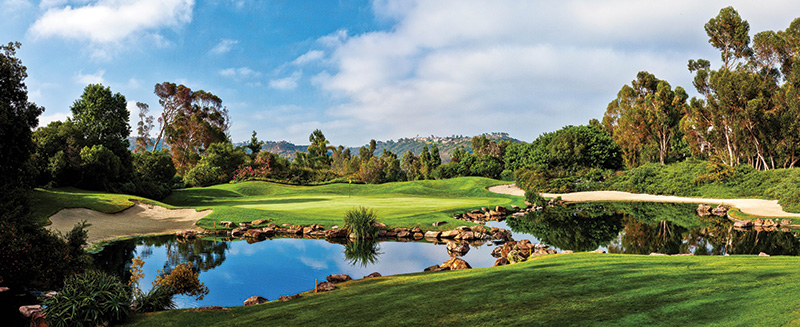
Hole No. 18 at Omni La Costa Resort & Spa’s North Course, which will host the GCSAA National Championship Feb. 2-3. Photo courtesy of La Costa Resort & Spa
David Smallwood has served as director of agronomy in Hawaii, New Jersey and the Caribbean. He has amassed a lot of experience.
He hasn’t experienced anything like this.
Hosting the GCSAA National Championship as part of the annual GCSAA Conference and Trade Show is a new one for Smallwood, GCSAA Class A director of agronomy at Omni La Costa Resort & Spa in Carlsbad, Calif. Speaking of new, this will be the first time the association will hold its GCSAA National Championship, on Feb. 2-3, there since the famed North Course has been renovated.
A 21-year GCSAA member, Smallwood is aware that a slew of eyes will be on his work. His bring-it-on approach is what you would expect from those who do what he does. “They’ll be looking at your product. You want to be on top of your game, show everybody what your team has done,” Smallwood says.
The championship on his course isn’t all that’s going down at La Costa — and other courses in the area, too, during the entire GCSAA Championships. La Costa’s South Course (Golf Classic on Feb. 2-3) is on the docket. At Torrey Pines, the North Course has Four-Ball (on Feb. 1) and Golf Classic (Feb. 2-3), and South Course will hold the Golf Classic (on Feb. 2-3). Park Hyatt’s Aviara Golf Club has Four-Ball on Feb. 1 and Scramble on Feb. 2 at the facility in Carlsbad.
When golfers go to work at La Costa, they will encounter a facility with quite a distinct and rich history. The North Course has held PGA Tour and LPGA Tour events throughout the years. The PGA Tour moved there 55 years ago, in 1969, to the North Course for the Tournament of Champions. Notable winners there for the event that was staged through 1998 include Jack Nicklaus, Tom Watson and Gary Player, all of whom are past recipients of the GCSAA Old Tom Morris Award. When it was the WGC-Accenture Match Play Championship from 1999-2006, Tiger Woods triumphed in one of them.
Those well-decorated players, though, never participated on the North Course when it looked like this. In June of this year, the North Course held its full reopening after an extensive renovation by Hanse Golf Course Design. Gil Hanse and his design firm partner Jim Wagner went to town on the North Course, which reverted to its original name after previously being known as the Champions Course. The North Course held its first marquee event earlier this year in May before the full reopening when it hosted the NCAA Championships for the men’s and women’s teams.
The North Course features six sets of tees ranging from 4,500 to 7,500 yards on the par 72 to accommodate players of all skill levels. The environment was taken into consideration, such as transitioning irrigation lines that will continue to use reclaimed water. Man-made ponds were removed, and there was a reintroduction to natural barrancas composed of drought-tolerant and native species.
Greens are Pure Distinction bentgrass that were rebuilt to USGA specs. “Significant traits on these greens are how much movement there is in them. Some of it you clearly see, but some areas aren’t clear the first time you play the course. There are two greens (Nos. 6 and 18) that have massively sloped perimeters that you must account for as you hit your approach shot into them,” says Smallwood. “I really like the new greens and how they fit into the course. And it (Pure Distinction bentgrass) has been a great variety to manage.”
The fairways still are 419 bermudagrass, but fraise mowing removed the old 419 bermudagrass, and all of it has been sprigged out to its current state. The roughs are 419, too, and extend out to native areas that feature an improved barley meadow and Pacific fescue. “When we hosted the NCAAs in May, we didn’t start growing until late March. We came out of dormancy and mowed the formal rough at 2 inches, just let it go. It got close to 4 inches in some areas. Typically, it’s 13⁄4 playing height. It’s dense, and there’s a lot of fliers,” Smallwood says. Ribbon tees were rebuilt, easing the mowing process, he says. Fairway mowers are implemented for everything from all the way through approaches and around greens.
GCSAA National Championship participants will encounter numerous risk-reward situations and some changes from the previous layout, including a drivable par-4 on No. 11 and a repositioned green on the par-3 16th, which will have a familiar look. “When Gil Hanse redesigned that green, he wanted a replication of hole No. 12 at Augusta National (home of the Masters). “It’s over water. The bunkering on the greens complex is identical as well. For the NCAA Championships back in May, we had low-mow turf straight into the pond on the front of the green and around the back and right of it like Augusta. Our membership has since requested that we let some of those areas grow back to rough height.”
The long par-4 14th with a smallish green near a lake was one of the top three toughest holes during the NCAA event. The two finishing holes feature a long par-4 at No. 17 in which the fairway drive is key and ultimately requires a long iron into an elevated green. The 600-plus-yard, par-5 No. 18 could be quite intriguing down the stretch of the GCSAA National Championship: a tee shot into a prevailing wind and water on both sides of the fairway. A bottlenecked fairway and a creek that runs in front of the green with a false front await those who want to make it there in two.
Besides the North Course, the South Course also was rebranded and is part of the resort’s legacy. Previously, it was known as the Legends Course. The South Course is a parkland style with mature trees and gentle doglegs that places a premium on accuracy off the tee. Holes Nos. 10-18 were used for the Mercedes Championship from 1995-98, which includes Woods notching a victory in 1997.
Smallwood and his team, including North Course superintendent Jeff Wilson, and eight-year GCSAA member, and South Course superintendent Daniel Manning, are thrilled to engage those who do what they do daily when the GCSAA National Championship rolls into town. “Anytime you can host an event of your peers who make up our industry is special,” Smallwood says. “I look forward to seeing friends I haven’t seen in a while and meeting new faces. Our team at La Costa are all looking forward to this event.”

The Park Hyatt Aviara Golf Club in Carlsbad, Calif., has hosted past GCSAA Golf Championships. Here is the No. 8 hole. Photo courtesy of Aviara
A familiar face at Aviara
Kevin Kienast, CGCS, played college football back in the day. Come February, his peers will try to tackle his golf course.
Since 2003, Kienast has worked at Park Hyatt’s Aviara Golf Club in Carlsbad, Calif. It will be the site for the GCSAA Golf Championship’s Four-Ball on Feb. 1 and Scramble on Feb. 2. The first time that Kienast hosted the GCSAA Championships was 20 years ago, his second year at the club, after previous stops that include Omni Tucson National Resort in Arizona.
What can those who tee it up during the GCSAA Championships expect? “It’s a challenging layout. You will probably hit every club in your bag,” says Kienast, a 28-year GCSAA member and Michigan native who grew up in Washington state. “You can work the ball different ways. The par 3s here stand out, guarded by water.”
Aviara GC has made significant changes since last hosting the GCSAA Golf Championships. A course renovation in 2022 led to regrassing rough and tees, and bunkers were redone. Those moves affected Kienast and his team’s way of doing business. “It changed the way we maintain the course,” he says. “We used to always overseed in the fall. Now, we won’t have winter ryegrass, and we don’t go totally dormant. We are much more playable year-round.”
TifTuf bermudagrass holds its color a little longer in winter. Drought-tolerant turf means 20% less water use annually, which saves about 25 million gallons of water each year. The Arnold Palmer Design layout opened in July 1991, and it has hosted numerous LPGA Tour tournaments. Aviara GC has escalated its stance on sustainability. There are more than 80 species of migratory birds at the nearby ecological reserve, where it and Aviara GC coexist with birds and wildlife in harmony.
“We want to be great stewards of the land,” Kienast says.
GCSAA Golf Championship participants will test that land at the just-over-7,000-yard, par-72 course, where the landscape includes native wildflowers. Although the par-3 greens are large, they’re not necessarily easy. For example, take the 189-yard No. 11. Although it possesses an 18 handicap and looks straightforward with just three bunkers, the hole will snatch misguided tee shots. The front portion of the green is surrounded by water.
The 18th hole — rated a 2 handicap and 443 yards from the tees — certainly will catch a golfer’s attention. Kienast offers some tips at the par 4: “If you’re lucky enough to be in the fairway … otherwise, there’s water and OB ahead. I’ve dumped a couple in the water. It (No. 18) ruined many a round for me.”
Kienast is no stranger to hosting the GCSAA Golf Championships — or playing in it. The former fullback at Western Washington University has finished in the top 10 of his flight before and once won his flight. Part of hosting it is winning over peers during their time at Aviara GC. “It’s good for our facility to host supers,” Kienast says. “Maybe there’s a little added stress, but our crew embraces it, and we want to peak at the right time.”

Torrey Pines is a scenic and familiar spot in the world of golf, having hosted U.S. Opens, including the one Tiger Woods captured in 2008. Photo courtesy of Torrey Pines
A staple of San Diego golf
Torrey Pines Golf Course has had its moments.
Think Tiger Woods playing on a broken leg and beating Rocco Mediate in an 18-hole playoff to win the U.S. Open in 2008 on the South Course at the municipal facility.
Thirteen years later at that same course, Jon Rahm birdied the final two holes and became the first Spaniard to win a U.S. Open, which was his first major championship.
In February, more championships are at stake at Torrey Pines in La Jolla, Calif. The North Course will host the GCSAA Championships’ Four-Ball on Feb. 1 and the Golf Classic Feb. 2-3. The South Course is hosting the Golf Classic on Feb. 2-3.
Devin Cullen, a 12-year GCSAA member, is program manager/senior golf course superintendent at Torrey Pines. He started at the facility in April 2016. Eight-year association member Travis Rebischke is a superintendent there.
Torrey Pines, which sits above coastal bluffs with views of the Pacific Ocean, hosts the PGA Tour’s Farmers Insurance Open and is known as one of the toughest tracks on tour. Torrey Pines opened in 1957.
Del Mar to host Scramble
Del Mar Country Club in the secluded valley of Rancho Santa Fe, Calif., will also host the Scramble on Feb. 2.
Del Mar CC is an exclusive private club that features a championship golf course designed by prolific golf course architect Joseph Lee and is designed to challenge golfers of every skill level.
With five sets of tees, the par-72 course plays from 5,386 to 7,226 yards.
Jason Jung, an eight-year GCSAA member, is the Class A superintendent there.
Howard Richman (hrichman@gcsaa.org) is GCM’s associate editor.